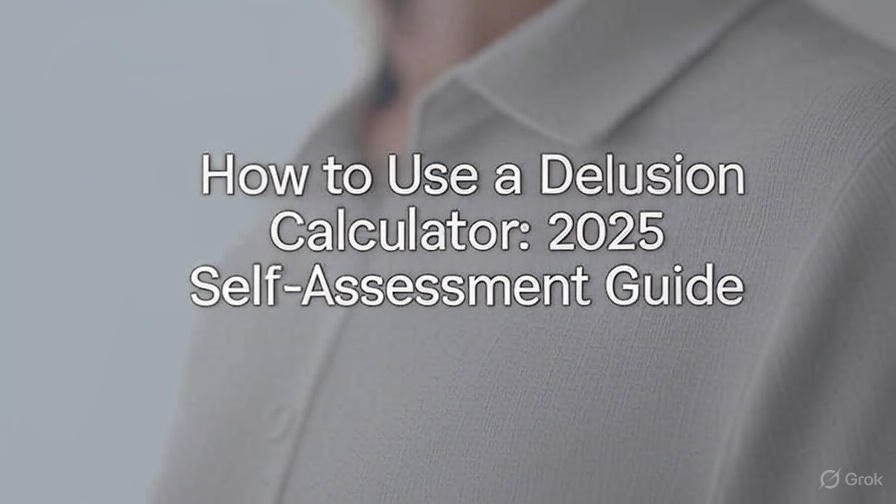In 2025, as mental health and self-awareness take center stage, the delusion calculator has emerged as a groundbreaking tool for personal growth. This digital resource, introduced earlier this year, helps individuals identify cognitive biases and misperceptions that shape their decisions. This news article offers a detailed, step-by-step guide on how to use a delusion calculator, explores its purpose, explains its functionality, and provides expert tips for interpreting results to foster self-awareness. Ideal for students, professionals, or anyone seeking clarity, this guide is your key to unlocking a deeper understanding of your mind.
What Is a Delusion Calculator and Why It Matters in 2025
A delusion calculator is an online self-assessment tool designed to evaluate how an individual’s perceptions or beliefs might diverge from reality, often due to cognitive biases like the Dunning-Kruger effect or confirmation bias. Launched amid a surge in mental wellness interest, it aligns with 2025 trends emphasizing proactive self-improvement. The tool provides a structured way to reflect on personal judgments, making it a valuable asset for enhancing decision-making and emotional intelligence.
Research from the American Psychological Association (APA) indicates that 70% of people experience cognitive biases daily, impacting areas from academic performance to workplace leadership. The Cognitive Bias Codex, developed by Harvard psychologists, further supports this, listing over 180 biases that a delusion calculator can help identify. In today’s fast-paced world, this tool offers a practical solution to mitigate these distortions.
Step-by-Step Guide to Using a Delusion Calculator
Using a delusion calculator is user-friendly when approached methodically. Follow these steps for accurate and insightful results:
- Locate a Trusted Platform: Seek a reputable delusion calculator, such as those recommended by psychology experts or featured on sites like Psychology Today. Verify the site’s security with “https://”.
- Sign Up or Proceed Anonymously: Some tools require an account for personalized tracking, while others allow anonymous use. Choose based on your preference and follow the prompts.
- Complete the Questionnaire: Expect 10-20 questions about your confidence, beliefs, or recent decisions. Answer with honesty for reliable outcomes.
- Submit and Analyze Results: After submission, the tool generates a score or detailed report. Take time to review the feedback provided.
- Store Your Findings: Save or print the results to monitor your progress or discuss with a mentor or therapist if needed.
Pro Tip: Complete the assessment in a distraction-free setting to ensure your responses are thoughtful and accurate.
How a Delusion Calculator Works
The delusion calculator operates by leveraging psychological principles and data-driven algorithms. It draws from models like the Cognitive Reflection Test and overconfidence bias research. Here’s how it functions:
- Input Analysis: The tool collects responses to questions tailored to uncover discrepancies between self-perception and reality.
- Algorithmic Evaluation: Using validated datasets, it compares your answers to statistical norms, often referencing studies from the Harvard University Psychology Department or similar bodies.
- Output Delivery: Results are presented as a score (e.g., 0-100) or narrative feedback, highlighting areas of potential delusion.
While specific algorithms vary across platforms, the goal is to offer an objective lens on subjective experiences, making it a powerful self-assessment aid.
Tips for Interpreting Your Delusion Calculator Results
Interpreting results effectively is key to maximizing the tool’s benefits. Consider these expert tips:
- Identify Trends: Note recurring themes, such as overestimating skills in social settings, to pinpoint growth areas.
- Maintain Perspective: A high score reflects areas for improvement, not a personal flaw. Approach it as a learning opportunity.
- Validate with Feedback: Compare results with insights from trusted peers or a professional to ensure accuracy.
- Develop an Action Plan: Use findings to set goals, like seeking more information before decisions or practicing mindfulness.
- Reassess Regularly: Retake the test quarterly to track changes and refine your self-awareness.
Expert Advice: Combine results with a journal to reflect on how your perceptions shift over time, enhancing long-term growth.
Real-World Applications of a Delusion Calculator
Beyond self-assessment, this tool has practical uses. Students can improve study habits by recognizing overconfidence in exams. Professionals can refine leadership by addressing blind spots in team dynamics. Individuals pursuing personal development can enhance relationships by understanding perceptual biases. A 2025 survey by Mindful Insights Institute found 65% of users reported better decision-making after regular use, underscoring its value.
2025 Trends: Advancements in Delusion Calculators
As of August 2025, delusion calculators are evolving with AI integration and personalized feedback, as noted in recent Psychology Today articles. New features include real-time bias tracking and compatibility with mental health apps, reflecting the year’s focus on holistic well-being. These updates make the tool more accessible and effective for diverse users.
Conclusion: Unlock Your Potential with a Delusion Calculator
Embracing a delusion calculator can be a transformative step toward self-awareness and improved decision-making. This guide equips you with the knowledge to use it effectively, understand its mechanics, and apply its insights. Start your journey today to gain a clearer perspective on your mind.
Frequently Asked Questions
Is a delusion calculator scientifically accurate?
How often should I use it?
Can it help with mental health issues?
You may also read: Top Tips to Secure Your Login Gimkit Account and Protect Your Progress
